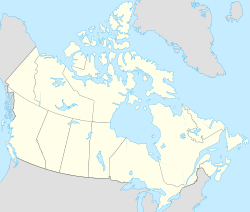Montmartre, Saskatchewan
| Montmartre | |
|---|---|
| Village | |
 |
|
| Motto: Paris of the Prairies | |
| Location of Montmartre in Saskatchewan | |
| Coordinates: 50°12′47″N 103°24′54″W / 50.213°N 103.415°WCoordinates: 50°12′47″N 103°24′54″W / 50.213°N 103.415°W | |
| Country | Canada |
| Province | Saskatchewan |
| Region | Saskatchewan |
| Census division | 6 |
| Rural Municipality | Montmartre |
| Post office Founded | 1894 |
| Government | |
| • Mayor | Robert Chittenden |
| • Administrator | Brenner Dale |
| • Governing body | Montmartre Village Council |
| Area | |
| • Total | 1.70 km2 (0.66 sq mi) |
| Population (2011) | |
| • Total | 476 |
| • Density | 279.8/km2 (725/sq mi) |
| Time zone | CST |
| Postal code | S0G 3M0 |
| Area code(s) | 306 |
| Highways | Highway 48 |
| Website | Montmartre website |
Montmartre (pron: Mo` mart) is a village in the Canadian province of Saskatchewan 91 km east of Regina on Highway 48.
It is located in the provincial electoral district of Moosomin and the federal electoral district Wascana.
According to archaeological discoveries, Paleo-Indians inhabited the lands of what is now southern Saskatchewan, including the Montmartre area, since 9500BCE. Paleoindian means "ancient Indian". The finding of spearheads and bones indicated that people lived on the land for hundreds of years. The Paleo-Indians were a hunter gatherer society who hunted mainly large game animals, such as bison and buffalo.
The Assiniboine people, a branch of the Sioux, referred to themselves as Nakota's people. They occupied the southern portion of the plains after migrating from the Devil's Lake Region in the United States. The early Jesuits mention the Assiniboine as a strong and hardy people living in the forest band lake regions around Lake Winnipeg as early as 1640. The Nakota people shared an allied relationship with the Nehiyawak or Cree, who occupied the Canadian Shield and boreal forest from what is now northern Quebec to northern Alberta. As allies, the Nehiyawak and Nakota traded with the Mandan south to the Missouri River, and occasionally made war on the Lakota (Sioux), Dakota (Sioux) and Atsina (Gros Ventre) to the southeast and southwest.
In the early 1800s, fur traders traveled the southern plain (formerly North West Territories) to make exchanges with the Cree, Sioux and Assiniboine people. These groups joined together were referred to as the Iron Confederacy. After the fur traders discovered indigenous nations, they began referring to the people as the "Plains Indians". Around the 1820s the settles and indigenous hunters began killing bison for trade in more vast numbers, with the introduction of guns and horseback transportation. By the late 1870s, the buffalo were extinct and their hunting depleted.
...
Wikipedia


